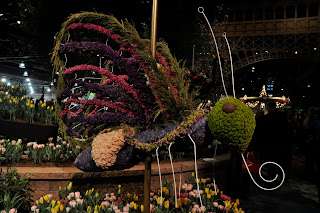When visiting the Philadelphia Museum of Art I had looked for a work that had caught my attention not just because I enjoyed how it was painted but also because I had actually felt something while viewing it. Though I had encountered a few works that made me stop and look, the one that stuck with me the most was “Carnival Evening” by Henri Rousseau. At the time, I wasn’t very familiar with his work other than “Sleeping Gypsy.” There was another one of his paintings placed next to “Carnival Evening” (titled "The Merry Jesters") but I was interested in "Carnival Evening" more. At first glance I noticed the coloring of the painting and stopped to examine it some more. I was curious about what was happening in the scene and decided it appeared a bit creepy. I then read the description on the side panel on the wall that explained the subjects and the scene of the painting, which gave it an eerie feel.
 |
| "Carnival Evening" Henri Rousseau. Oil on Canvas. 1886. |
The painting shows two dark figures dressed in carnival outfits, the man looking almost like a clown; the woman in a dress with a cone shaped hat, standing in a dark forest. Their faces are difficult to make out completely, however they seem quiet and sad, unlike the joy one would expect to feel if having just been at a carnival. The sky is a dark indigo color with a bright moon and gray clouds at the bottom. The description on the wall mentions how the light from the moon somehow leaves the forest in darkness, and the figures are glowing from within. Even though this use of light wouldn’t be true in real life, it works in the painting as it adds to its mysterious feel. To the left of the figures, there is what seems to be a floating face. I didn’t notice this face at first, I saw it only after reading the description that states “an unexplained face leers out from the empty hut beside the figures, and an unexpected street lamp incongruously grows nearby.” I still can’t find the street lamp but the random floating face is what also made the painting feel eerie. The figures are isolated and seem somewhat lonely, even though they are together. Overall the scene is very quiet and seems as though there is danger lurking.
I wanted to learn about the meaning behind the painting but I couldn’t find much online. However, not knowing the definite meaning and reasons Rousseau created this painting adds to its mystery. While researching I've discovered his other paintings and have noticed his subject matter involves a theme of fantasy that isn't completely straying away from reality. Also while reading online I learned how his art wasn’t taken seriously and often ridiculed. Mostly this was due to his “childish” style, however I feel as though his style works well with his paintings because of their themes. I enjoy the fantasy aspect of his work since it provides the viewer with something to wonder and think about when viewing his paintings, such as the story they are trying to tell, rather than just looking at them and walking away. This makes me appreciate his work even more, especially "Carnival Evening," since not only is it painted well but there is more to it than just the paint on the canvas.




















